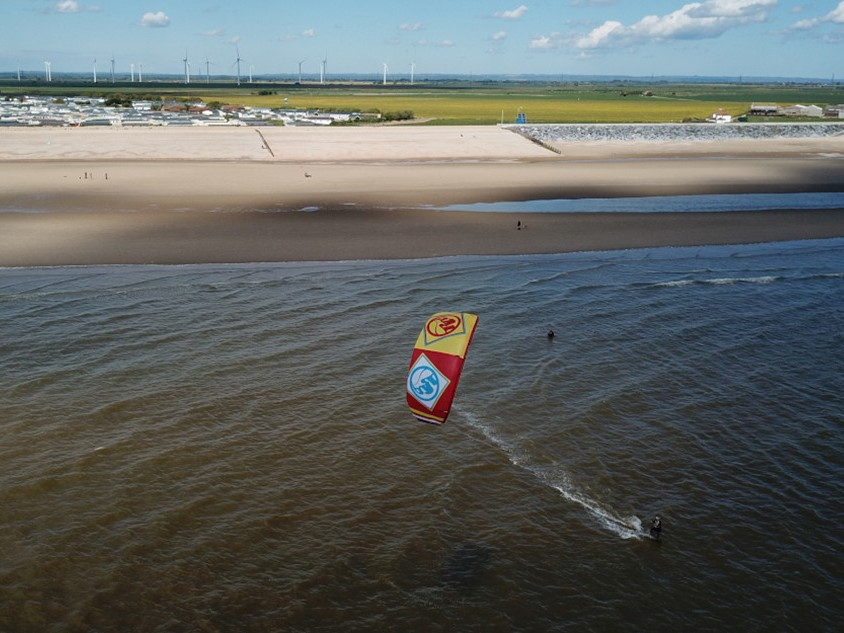The winds have finally swung round to blow from the south, at last blessing our shores with some clement air masses. With lockdown restrictions easing significantly next week, some of you may be keen to give something new a try. So here’s a little insight into to the wonderful world of kitesurfing, and how you can learn to become a kitesurfer. How hard can it be?
For anyone wanting to try, this will naturally be one of the first considerations. It will after all govern how much time, money and commitment will be required to experience the thrill of whizzing across the surface of the sea – and I remember the first time I saw a kitesurfer, zooming along the coastline of Aberdeen.
Despite the natural associations of playing around in the North Sea, I was immediately hooked with the idea of getting into kitesurfing, and willing to commit myself entirely to whatever it would take to be that person. But it looked like an extreme sport, and according to my preconceptions would therefore be hard to learn. Seven years on, I feel qualified to answer this question!
How easy is it to learn kitesurfing? Let’s break it down into the main points.
Prior Experience
Kitesurfing is 90% kite, 10% board. Although students with previous board experience, such as snowboarders or skateboarders, are advantaged, this is only marginal. Those with sailing experience tend to have a greater appreciation of the wind and it effects. No worries! This is theory that is taught in lessons, and is simple enough to understand.
Flying a kitesurfing kite, also known as an leading edge inflatable (LEI), is a new experience for every student, so when group lessons are taught, all students start from pretty much the same point. Teaching the theory of how a kite flies, developing the correct technique to fly a kite, and scaling that technique to the larger kites is a process that all students learn from. It ensures a solid flying technique that is the basis of development.
Gender
When kitesurfing was first getting going in the 90s, it was very much a male dominated sport, this largely due to the makeup of the windsurfing fraternity from which many kitesurfers originated. This has changed enormously since, with just as many women learning how to kitesurf as men.
There’s loads of independent female riders at Camber Sands, and if you need further convincing, just have a look at the pro scene. There is also a good balance of male and female instructors to teach you, and the choice for ladies specific equipment grows every year, with specific harnesses, wetsuits and boards on offer.
Age
I’ve taught students as young as 13, and as old as 73. One of the great things about this sport is that it doesn’t require a lot of strength or stamina, despite appearances. The usual assumption is that you hold onto the kite with your arms; after all it does look like this from a distance. The kite is actually hooked into a harness, and all you have to do is steer the kite, which is pretty easy-peasy.
I would say a minimum age is more relevant then a maximum age. A certain height and strength is required, as anyone too young will struggle to reach the bar, or steer a larger kite.
Costs
One thing that is fundamental is that you do have to have lessons. This is not a sport where you can simply buy a kite off eBay and have a go at learning yourself. There are a few variables that will affect the cost of learning. Some students are naturally faster at learning then others, and there are different ways of learning.
I would say an average spend on lessons would be £500 to £800. This will include a 3 day course, and some private lessons to refine technique. In terms of equipment there are different ways of doing this. You can buy new, you can hire, you can buy second hand, or perhaps even borrow from a good friend. There is an extensive second hand market, though make sure you research what you’re buying before purchase. Finally, once you’re kitted out, the wind is free!
Safety
There are a few necessary personal attributes – an ability to swim, patience and good consideration for others are required for sound kiting practice. The second crucial ingredient is to have lessons. Learning to kitesurf is a little like learning how to drive a car. You wouldn’t drive a car without lessons, and kitesurfing is no different.
There are rules of the road to learn, kite de-powering procedures to follow if something goes wrong, and general dos and don’ts to pick up from your instructor. These are easy to learn and simple enough to perform. The sport has progressed a long way since the dare-devil days of the early 90s when safety was given little thought.
Today, kitesurfing is taught all around the world. Governing bodies, such as the British Kitesports Association (BKSA), regulated schools and comprehensive curriculums have progressed the sport to be well taught, easy to learn and safe to do
To conclude
One of the best pieces of advice I could give is after your first lesson, buy yourself a little trainer kite and practice in your garden or park. These are great for establishing a solid kite technique.
All in all, if you are committed, kitesurfing is not a difficult sport to learn – how else would there be 1.5 million kitesurfers worldwide?
Image Credits: Alex Thomson .



